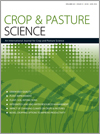CP18248A linked SNP marker to genotype Fr-B2 in wheat
 , J. Hyles, Jayne Wilson, Karen Cane, K. L. Forrest, M. J. Hayden, K. Ramm and Ben Trevaskis
, J. Hyles, Jayne Wilson, Karen Cane, K. L. Forrest, M. J. Hayden, K. Ramm and Ben Trevaskis
Frost tolerance locus FrB2 affects wheat grain yield in Australian environments. For this complex locus, we identified a linked SNP marker which can be used for breeding and research. This will facilitate development of cultivars adapted to specific regions of Australia.




